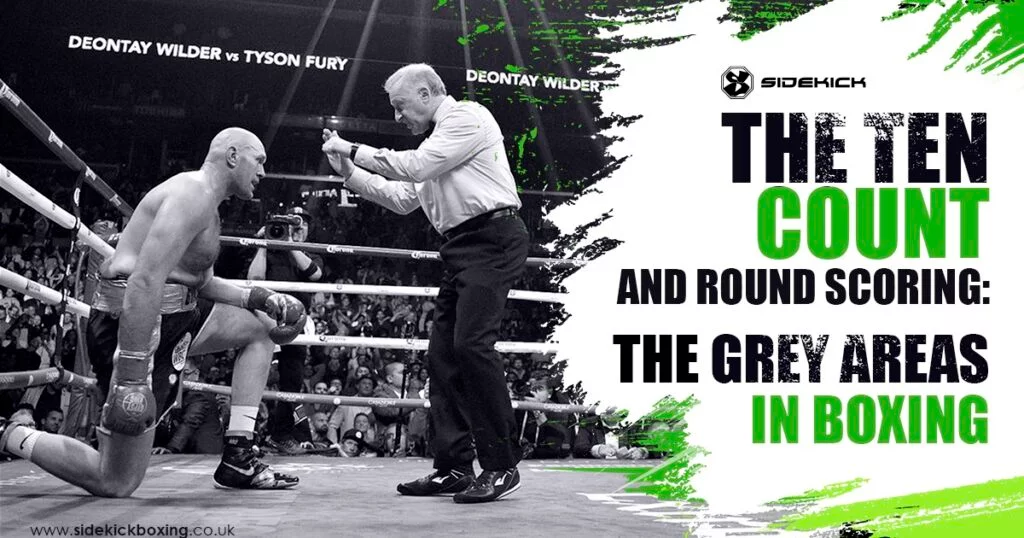
The 10 Count and Round Scoring: The Grey Areas in Boxing

A boxing fight is not always black and white when it comes down to who actually should of won, at least you would expect it to be, especially on a professional level.
Whenever a fight is over, we dive over to Facebook to put up a status of how the referee or the judges got it terribly wrong. After all, we are the boxing experts of Facebook.
We say how the score cards are not correct, and the wrong fighter was given the win, and even when a fighter gets knocked down we say he is gifted more than the 10 seconds count. But, the truth is that in boxing, some of the rules are not perfectly clear and that each organisation may have their own way of doing things.
A boxing fight generally ends in one of two ways, if a fighter doesn’t manage to knock out their opponent during the fight, it goes the duration and the decision is collectively made up by all three judges scorecards.

When a fighter is knocked down, the referee has to act immediately and the slightest bit of hesitation, leaves the fans believing the referee did it on purpose to favour a fighter. Also, if it does go to points, the judges scorecards can vary dramatically which could be seen as odd, especially considering they are all watching the same fight.
In an ideal world, all judges should all have the same scores, but in fact different judges can have mixed scores to which fighter is the winner. With the scorecards varying dramatically is another good reason to why the fans believing it is down to favouritism of a fighter, yet majority of the time their is a simple explanation.
A good reason for this is that each judge watches the fight from different sides of the ring, so each one will observe and see different elements of the fight. It can also be the same for us fans at home when we watch it on the TV, we can see it completely different to the judges. Of course, corruption does go on in boxing, but most of the time it can simply be a grey area in the rules.
Read our article ‘Is Boxing Corrupt?’ here.
So, what are the grey areas in boxing?
As mentioned above, the scoring is always a grey area in boxing, as it is an opinion of the judges to who wins each round, rather than an official score like you would see in most other sports.
This is why for competitions they try to use neutral judges that won’t be biased and for World championship fights they use judges from non-conflicting countries. Another grey area in boxing is what should happen when a fighter goes down and gets a ten count.

So, What is the ten count in boxing?
When a fighter gets knock down, they are given the ten-count (10 seconds) counted by the referee, which was originally introduced to boxing as “the gentleman’s rule” as in to never hit an opponent while he is down. While a fighter is down, he has 10 seconds to rise to his feet and be checked fit before the fight can comense.
You would think the ten second count would be quite self explanatory and just a case of counting to ten. However, In some of the boxing organisations rules the knock down rule doesn’t have clear outlines to what exactly is the correct procedure, that many boxing fans believe the referee may bend the rules depending on the fighter.
Their has always been disputes to exactly how long a fighter gets to get back up off the canvas and it is suggested that some of Mike Tyson’s opponents had up to 14 seconds. Let’s face it, we could do with at least 10 minutes to get back up from a Mike Tyson punch, let alone 10 seconds.
Even though the referee should stick to the rules to the best of his ability, the referee is capable of giving a better or worse chance for a fighter to make it up in time.
The favourite fighter
When it is the home, or the headline fighter for the promotion, people think when the fighter goes down, the referee may be a bit more relaxed on initiating the count. The referee may also wait for the opponent to reach the neutral corner before commencing the count and allow the fighter to stand on the 10th second.
When the fighter is up, the referee could give extra seconds to make sure they are OK and some are seen holding the fighter up, but this could just be a close look and a duty of care before allowing the fighter to carry on.
The out-of-town fighter
When a fighter is the away fighter, or even a journeymen, people think the referee may start counting immediately without any time lapse to allow for the first second, so the time is definitely up against them and the referee could easily wave it off.

So, what is the procedure of a knock down rule?
Each organisation should have the same rules for a knock down, however, some organisations including the Bbbofc don’t clarify it in full detail in their own rules.
It has always been known that when an opponent gets knocked down, the referee sends the other fighter to a neutral white corner before starting to count. The referee sends him to the neutral corner so his corner team can’t give advice for when the fighter gets back up.
Also, if the fighter comes out of the neutral corner the referee will stop counting and resume the count once the fighter is back in the corner, yet this part of the rule is not stated in some organisations rules.
If the fighter doesn’t stand up by the count of ten, the fight is waved off with the other fighter being declared the winner.
The WBA has a very detailed rule regarding the ten count which is:
When a boxer is knocked down, the referee shall order the opponent to retire to the farthest neutral corner of the ring in relation to the down boxer, pointing at such corner, and he shall immediately count the seconds in a loud voice, with a movement of his arm, taking the count from the timekeeper.
If the boxer refuses to go to the farthest corner determined by the referee, or does not stay there, the referee shall stop the count to the down boxer until his opponent retires to the indicated corner, and then the referee shall continue with the count starting from the point from which it was interrupted.
If the downed boxer does not rise before the count of ten (10), he will be declared the loser by KO (Knockout), and the referee shall make it known by waving both arms. A boxer who rises and can continue the bout shall receive a minimum count of eight (8) seconds.
In kickboxing, the ten count has the same rule as in boxing and the WKA states:
Whenever a contestant is knocked down, the referee shall order the contestant’s
opponent to retire to the farthest corner of the ring, pointing to the corner and immediately
begin the count over the knocked down contestant. The referee will audibly announce the
passing of each one-second interval, indicating its passage with a downward motion of
the arm.
Any time a contestant is knocked down, the referee shall automatically begin a mandatory eight-count and then, if the contestant appears able to continue, will allow the fight to resume.
Standing 8 Count Rule
The standing 8 count rule was first introduced in 1982 as a way of protecting the fighters safety. The rule allows the referee to intervene in the fight and start counting who appears to be a hurt fighter.
However, this rule is no longer in professional boxing as it was revoked in 1998.
If you watched the Undisputed fight between Fury vs Uysk, the referee started counting Fury in the 9th round. It gave so much controversy, especially as Fury didn’t go down.
But in fact, the referee didn’t give Fury a standing 8 count, he considered him knocked down. The ropes and corner post prevented Fury from going to the canvas, so this is still considered a knock down in boxing and the referee made a good call.
Point Scoring in Boxing
in boxing and kickboxing they score each bout with what is called a ten point must system. This is were both opponents start each round with 10 points and deducted points for losing the round, knockdowns or fouls. So, the winner of the round gets 10 points and the loser gets 9. However, if the loser of the round also goes down it will make it 10-8 round.

How is a round scored in boxing?
The judges look for certain skills and performances of each fighter to determine who wins each round.
Judges look for who is:
- More aggressive
- Throwing the most strikes
- Cleaner strikes
- Harder and more damaging strikes
- Better defence
- Better ring craft and movement
So with both fighters performing very evenly, it sometimes can be difficult to determine a winner of each round. Also, the judges could have different views to what they regard as the better fighter, this is why judges may score differently. A great example of this is when Floyd Mayweather Jr fought Oscar De La Hoya back in 2007, Floyd’s dad claimed his son should of lost on the ten point must system.
Final thoughts
Even though a boxing fight has its official result, with the ten count rule and round scoring, with different judges and referee, the boxing fight may have a different outcome.







